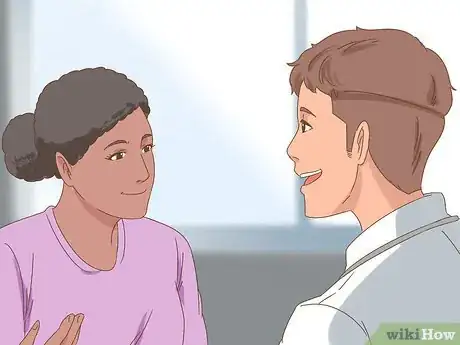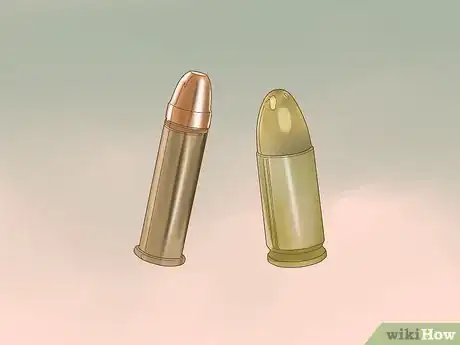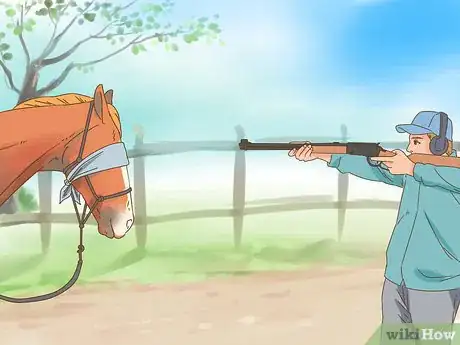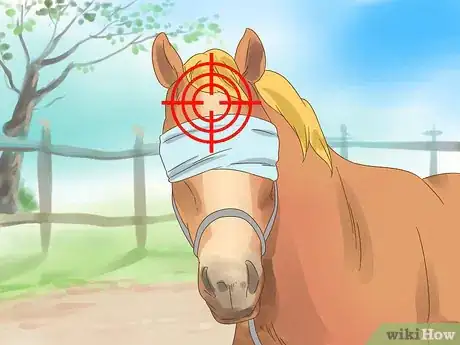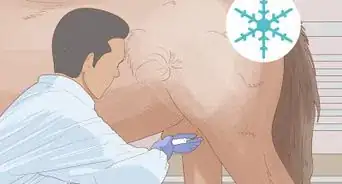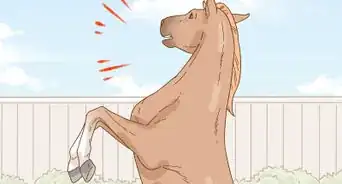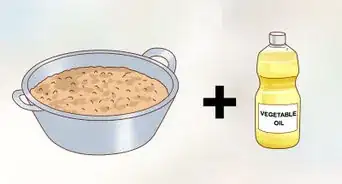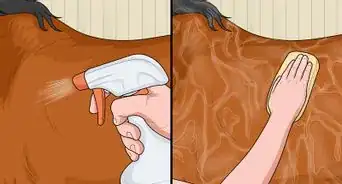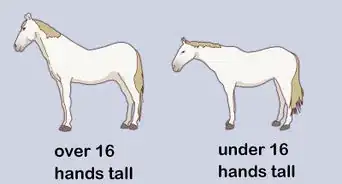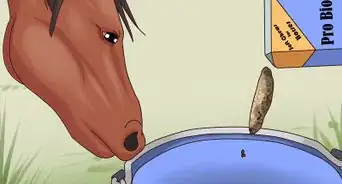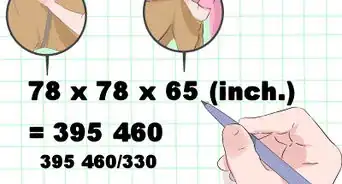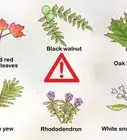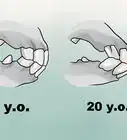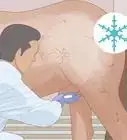This article was co-authored by Pippa Elliott, MRCVS. Dr. Elliott, BVMS, MRCVS is a veterinarian with over 30 years of experience in veterinary surgery and companion animal practice. She graduated from the University of Glasgow in 1987 with a degree in veterinary medicine and surgery. She has worked at the same animal clinic in her hometown for over 20 years.
wikiHow marks an article as reader-approved once it receives enough positive feedback. In this case, several readers have written to tell us that this article was helpful to them, earning it our reader-approved status.
This article has been viewed 164,496 times.
Euthanasia is a humane way of putting an animal to death. It can be very emotionally difficult to think about euthanizing your horse, but there are situations in which euthanasia is the only way to end your horse’s suffering. Knowing when, why, and how to euthanize will help you be better prepared when it comes time to make that decision.
Steps
Preparing to Euthanize Your Horse
-
1Select the date for euthanasia. If the euthanasia is not an emergency, decide when you would like the euthanasia to take place. This will give you time to take care of the logistics of euthanasia, such as coordinating the removal and disposal of your horse’s body. This will also give you time to discuss your decision with your family members, friends, and stable manager.[1]
-
2Check your insurance policy. If you have a mortality insurance policy on your horse, carefully review your policy before euthanizing your horse. There may be provisions in that policy specifying the insurance company’s process of authorizing euthanasia. On top of the already emotionally difficult decision to euthanize, you do not want to create more stress for yourself if your decision to euthanize goes against the insurance policy.[2]Advertisement
-
3Arrange for your horse’s removal. If the euthanasia is not an emergency situation, take time beforehand to coordinate your horse’s removal, and, if permitted by law, burial. Contact a disposal service that will remove your horse’s body for you.[3]
- Other than burial, you have the option of having your horse cremated or rendered. Contact companies that provide these professional services if you prefer non-burial options.[4]
Discussing Euthanasia With Your Veterinarian
-
1Learn the situations when euthanizing is appropriate. There are a number of medical reasons for which euthanasia would be appropriate. Your veterinarian can help you identify if your horse has these conditions.[5]
- Severe traumatic injury
- Chronic severe lameness
- Inoperable colic
-
2Decide whether you should euthanize your horse. Deciding whether to euthanize your horse is a difficult one. If you have the time to decide, consider going over some questions with your veterinarian. You want to be sure that you are making the right decision for you and your horse.[6]
- Is my horse suffering?
- Can I continue to take on the financial burden of caring for my horse?
- Are there any alternatives to euthanasia for my horse?
- How will long will my horse suffer in his current state?
-
3Understand the different methods of euthanasia. There are several acceptable methods of euthanasia that are acceptable for horses, including barbiturates and penetrative captive bolt. Your veterinarian is licensed to use these methods and will be able to explain these methods to you. With this knowledge, you can make a more informed decision on what method of euthanasia would be most suitable for your horse, given his current medical condition.
- Barbiturates are drugs that depress the nervous system. Given as an overdose via intravenous injection, barbiturates will first cause unconsciousness, then depression of breathing, and finally cardiac arrest. The most commonly used barbiturate for equine euthanasia is called sodium pentobarbital. Only your veterinarian can administer barbiturates.
- The use of a penetrative captive bolt is another acceptable option that your veterinarian can perform. A penetrative captive bolt causes a concussion and major brain damage, resulting in immediate unconsciousness. This method is more commonly used in cattle for slaughtering purposes.
- Your veterinarian can also use potassium chloride (KCl) via intravenous injection while your horse is under anesthesia.[7] An overdose of KCl causes cardiac arrest and eventual death.
- There are also euthanasia methods (eg, gunshot, electrocution) that are classified as ‘conditionally acceptable’ because they may not consistently lead to a humane death or have not undergone extensive scientific testing. They also pose a high risk for human error or injury.
-
4Understand your veterinarian’s role in euthanasia. It is very important to remember that the decision to euthanize rests with you. Although there may be emergency situations where the veterinarian has to make the professional decision to euthanize without owner’s consent, this is very rare.
- Realize that asking your veterinarian what they would do can put them in an uncomfortable position, since they are not your horse’s owner and do not have the same emotional and financial attachment to your horse that you do.[8]
- Also keep in mind that your veterinarian may refuse to support your decision to euthanize, if they feel like your horse’s medical condition does not warrant euthanasia.[9]
- Consider seeking a second option from another veterinarian if you are still undecided after speaking with your veterinarian.[10]
Euthanizing Your Horse Using a Gun
-
1Choose a firearm. Gunshot is commonly the only practical method of euthanasia when veterinary assistance is not available. Either a pistol or rifle will be suitable for euthanizing your horse via gunshot. The advantage of using a pistol is that you can hold the pistol in one hand and hold your horse’s lead rope in the other hand; this is useful if your horse is standing and there is no one to help you hold the horse.
- If you only have access to a rifle, then someone else will need to hold the horse because you will have to use both hands to hold the rifle.
- There are several types of shotguns that you can use. Either the 12, 16, or 20 gauge shotguns loaded with slugs (heavy lead or copper-coated projectile) are appropriate for use on a horse.
-
2Select the appropriate ammunition. The most commonly used bullets are either .22 caliber or .38 caliber. In younger horses, whose skulls are not as thick, the .22 caliber would likely be sufficient to penetrate the skull. In older and larger horses with thicker skulls, it is recommended to use the larger .38 caliber to ensure that the bullet penetrates the skull.
- Use a soft-nosed bullet that is hard-cast of lead, rather than a bullet that is encased in a full metal jacket. This reduces the chance that the shooter or a bystander will get injured when the gun is fired.
- Remember that the goal of selecting the proper firearm and ammunition is to ensure that the bullet is large enough to penetrate the skull with enough velocity and energy to cause massive brain destruction and immediate death.
- Load the gun so that it will be ready for euthanasia.
-
3Choose a location for the euthanasia. Choose an area that can be easily reached by equipment to remove the horse for burial, cremation, or rendering. Following euthanasia, your horse’s body will enter a state of rigor mortis in about two hours;[11] once rigor mortis sets in, it will be extremely difficult to move your horse if he is in a stall or other small area.
- If your horse is in a smaller area and cannot be moved (down and unable to move, violently thrashing and not safe to approach), you will need to perform the euthanasia as safely as possible without moving the animal.
-
4Blindfold your horse. You will be standing in front of your horse to shoot the gun, so your horse would see what you’re about to do if he’s not blindfolded; this could cause him to become anxious and restless, making euthanasia more difficult to carry out. By blindfolding him, he will not be able to see what you are about to do and you will not have to look him in the eye.
- Do not attempt to blindfold your horse if he is thrashing and unsafe to approach.
-
5Stand in the proper position. Whether you are using a shotgun or rifle, you will need to stand in front of the horse, but slightly off to the side (if your horse is standing). If you are using a shotgun, hold the shotgun in one hand and the lead rope in the other. If you are using a rifle, use both of your hands to hold the rifle and have the other person holding the lead rope to stand behind you; they should stand behind you for their protection.
- Stand two to three feet away from your horse.
- Your horse may fall directly forward following the gunshot (rather than to the side), which would be very dangerous for you and whoever is assisting you if you are standing directly in front of the horse. Standing off to the side will protect you if your horse falls forward.
- If possible, stand uphill from your horse. If he falls forward, the force of gravity will not push his body forward towards you.
- If there is anybody else witnessing the euthanasia, make sure that they are standing behind you for their protection.
-
6Aim your gun. To ensure that the bullet enters the skull at the proper location, draw two imaginary lines. Draw one line from the right ear to the left eye, and the other line from left ear to the right eye. The intersection of these two lines should be exactly in the middle of your horse’s forehead and at the bony ridge of the skull.[12]
- Aim your gun slightly off center from where the lines intersect to avoid the bony ridge.
- Do not place the muzzle of the gun directly on your horse! This could cause serious injury to you, since the gunpowder and gas could get confined in the gun and result in an explosion in your hand. Also, the bullet will enter the skull with more velocity if you keep the gun two to three feet away from the bullet entry point.
- Getting the correct aim will be easier to do if the animal is standing and still. If the animal is lying down in an awkward position, aim down the neck.
- If your horse is thrashing, try to aim for the head, neck, or lower chest near the elbow.
-
7Shoot the gun. Provided that your aim is correct, your horse should go down and his death should be immediate.[13] Be aware, though, that your horse may violently convulse even if the bullet entered the skull at the correct location. If this happens, make sure that everyone continues to stand as far as back from the horse for safety reasons.
- If you needed to initially aim for another part of the body because your horse was either in an awkward position or too mobile, you can wait until your animal is more still after the initial shot and then aim for the midpoint of the forehead.
-
8Ensure that your horse has died. There are multiple ways to check that your horse has died. One way is to listen for a heartbeat. Another way is to check your horse’s eyes. The eyes of a horse are very sensitive, so if the eyes react even to the slightest touch, your horse has not yet died.[14]
- To check the eyes, touch the cornea (clear covering over the eyes). If the horse blinks, your horse is still alive. Wait several minutes and try again. Once the eye no longer responds to your touch, you will know that your horse has died.
-
9Move your horse. It is ideal to have your horse moved before rigor mortis has set in. Once rigor mortis sets in, your horse’s body will become stuck in the position in which he died, which could make it very difficult to move him.[15]
References
- ↑ http://www.aaep.org/info/horse-health?publication=850
- ↑ http://www.horses-and-horse-information.com/articles/0198bye.shtml
- ↑ http://www.horses-and-horse-information.com/articles/0198bye.shtml
- ↑ http://www.horses-and-horse-information.com/articles/0198bye.shtml
- ↑ http://www.aaep.org/info/horse-health?publication=850
- ↑ http://www.aaep.org/info/horse-health?publication=850
- ↑ http://www.aaep.org/info/horse-health?publication=849
- ↑ http://www.aaep.org/info/horse-health?publication=850
- ↑ http://www.aaep.org/info/horse-health?publication=850
- ↑ http://www.aaep.org/info/horse-health?publication=850
- ↑ http://www.horses-and-horse-information.com/articles/0198bye.shtml
- ↑ http://www.horses-and-horse-information.com/articles/0198bye.shtml
- ↑ http://www.horses-and-horse-information.com/articles/0198bye.shtml
- ↑ http://www.horses-and-horse-information.com/articles/0198bye.shtml
- ↑ http://www.horses-and-horse-information.com/articles/0198bye.shtml
- ↑ http://www.aaep.org/info/horse-health?publication=850
- ↑ http://www.aaep.org/info/horse-health?publication=850
About This Article
Although putting down a horse is an emotionally difficult process, it can help to talk to your veterinarian, who will help you decide what method of euthanasia would be most suitable for your horse. Your vet can also help you select a date for the procedure so that you have enough time to discuss your decision with your family, friends, and stable manager. During this time, you’ll also need to arrange your horse’s removal and burial, or look into non-burial options such as cremation or rendering. For more advice from our Veterinary co-author, like how to make sure euthanasia is appropriate for your horse, keep reading.






